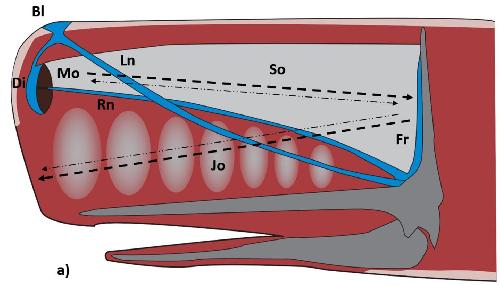An analysis of Mediterranean sperm whale 'clicks' suggests that individuals range from 7.5 to 14 meters long, according to a study published Dec. 9, 2015 in the open-access journal PLOS ONE by Francesco Caruso from the University of Messina and Laboratori Nazionali del Sud, Italy, and colleagues.
The authors of this study monitored whale sounds using an acoustic antenna ~2km deep, located off the coast of Sicily for almost two years, from 2005 to 2007. The antenna picked up the continuous multi-pulse signals, or 'clicks,' of diving sperm whales in the area. Each individual's clicks have a consistent time interval between pulses, resulting from the production of the sound within the sperm whale's head. The researchers analyzed over 2,000 recordings using algorithms to convert this interval into an estimate of sperm whale length.
Dr Caruso notes: "This work describes a new method for the automatic analysis of the clicks, which allowed the unsupervised processing of a large acoustic dataset."
 This is a photograph of a scheme of the sperm whale's head and sound production.(a) Bl: Blow hole; Di: Distal air sac; Fr: Frontal air sac; Jo: Junk organ; Ln: Left naris; Mo: Monkey lips; Rn: Right naris; So: Spermaceti organ. (b) According to the bent horn model, the production of a click generates multiple pulses (p0, p1, p2, p3 etc.). Credit: Caruso et al.
This is a photograph of a scheme of the sperm whale's head and sound production.(a) Bl: Blow hole; Di: Distal air sac; Fr: Frontal air sac; Jo: Junk organ; Ln: Left naris; Mo: Monkey lips; Rn: Right naris; So: Spermaceti organ. (b) According to the bent horn model, the production of a click generates multiple pulses (p0, p1, p2, p3 etc.). Credit: Caruso et al.
The authors found that the studied sperm whales ranged from around 7.5 to 14m long. Most whales were between 9 and 12m, likely either adult females or young males, while some whales shorter than 9m, representing juvenile females, but the researchers did not find any whales longer than 14m, which would represent older males. This study did not include any visual assessments of sperm whales, which the authors suggest would, in combination with acoustic methods, which might validate the findings and provide further insights.
Mediterranean sperm whales are listed as endangered according to the IUCN, with fewer than 2500 adults in the population. A better understanding of the population's composition will therefore help with its conservation.
source: PLOS